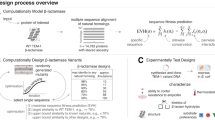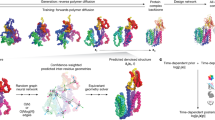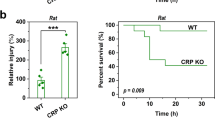Abstract
Zuckerkandl and Pauling1 have pointed out the potential value of proteins as documents of evolutionary history for the species from which they have been extracted, and various aspects of the structure of proteins have been used for this purpose. These include serological cross-reactivity, amino-acid composition, peptide maps, electrophoretic mobility, catalytic activity and chromatographic characteristics2. It is generally agreed, however, that the greatest insights in this area are liable to come from comparisons of the primary structure of proteins, that is by partial or complete amino-acid sequence determination, for only these comparisons are likely to indicate accurately enough the mutation distance between the homologous genes involved.
This is a preview of subscription content, access via your institution
Access options
Subscribe to this journal
Receive 51 print issues and online access
$199.00 per year
only $3.90 per issue
Buy this article
- Purchase on SpringerLink
- Instant access to full article PDF
Prices may be subject to local taxes which are calculated during checkout
Similar content being viewed by others
References
Zuckerkandl, F., and Pauling, L., J. Theoret. Biol., 8, 357 (1965).
Vaughan, J. G., Science Progress, Oxford, 56, 205 (1961); Taxonomic Biochemistry and Serology (edit. by Leone, C. A.) (Ronald Press, New York, 1964); Evolving Genes and Proteins (edit. by Bryson, V., and Vogel, H. J.) (Academic Press, New York, 1965); Boulter, D., Thurman, D. A., and Turner, B. L., Taxon, 15 (4), 135 (1966); Dixon, G. H., Essays in Biochem., 2, 147 (1966); Chemotaxonomy and Serotaxonomy (edit. by Hawkes, J. G.) (Academic Press, New York, 1968); Nolan, C., and Margoliash, E., Ann. Rev. Biochem., 37, 727 (1968); Smith, E. L., The Harvey Lectures, 62, 231 (1968); Turner, B. L., Taxon, 18 (2), 134 (1969).
Sokal, R. R., Syst. Zool., 10, 70 (1961); Camin, J. H., and Sokal, R. R., Evolution, 19, 311 (1965); Edwards, A. W. F., and Cavalli-Sforza, L. L., Biometrics, 21, 362 (1965).
Dayhoff, M. O., and Eck, E., Atlas of Protein Sequence and Structure, 2 (National Biomedical Research Foundation, Maryland, 1966).
Fitch, W. M., and Margoliash, E., Science, 155, 279 (1967).
Romer, A. S., Vertebrate Palaentology, second ed. (University of Chicago Press, 1945).
Lawrence, G. H. M., Taxonomy of Vascular Plants (Macmillan, New York, 1951).
Dayhoff, M. O., Atlas of Protein Sequence and Structure, 4 (National Biomedical Research Foundation, Maryland, 1969).
Stevens, F. C., Glazer, A. N., and Smith, E. L., J. Biol. Chem., 242, 2764 (1967).
Richardson, M., Laycock, M. V., Ramshaw, J. A. M., Thompson, E. W., and Boulter, D., Phytochemistry, 9, 2271 (1970).
Thompson, E. W., Laycock, M. V., Ramshaw, J. A. M., and Boulter, D., Biochem. J., 117, 183 (1970).
Ramshaw, J. A. M., Thompson, E. W., and Boulter, D., Biochem. J. (in the press).
Gray, W. R., and Hartley, B. S., Biochem. J., 89, 279 (1963).
Heller, J., and Smith, E. L., J. Biol. Chem., 241, 3165 (1966).
Hempel, K., Lange, H. W., and Birkofer, L., Naturwissenschaften, 55, 37 (1968); Kuehl, W. M., and Adelstein, R. S., Biochem. Biophys. Res. Commun., 37, 59 (1969); Hardy, M., Harris, I., Perry, S. V., and Stone, D., Biochem. J., 117, 44P (1970).
Thompson, E. W., Richardson, M., and Boulter, D., Biochem. J. (in the press).
Author information
Authors and Affiliations
Rights and permissions
About this article
Cite this article
BOULTER, D., THOMPSON, E., RAMSHAW, J. et al. Higher Plant Cytochrome c. Nature 228, 552–554 (1970). https://doi.org/10.1038/228552a0
Received:
Revised:
Issue date:
DOI: https://doi.org/10.1038/228552a0
This article is cited by
-
Angiosperm origins
Nature (1989)
-
Pflanzenstoffe und Pflanzensystematik
Die Naturwissenschaften (1971)



